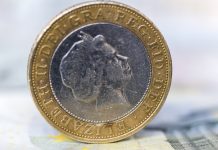After a fairly volatile session on Tuesday, the pound ended the day almost flat versus the US dollar. The pound US dollar exchange rate peaked in early trade at $1.4089, before dropping heavily to a low of $1.4021. The rate then climbed higher towards the end of the session.
| What do these figures mean? |
|---|
|
When measuring the value of a pair of currencies, one set equals 1 unit and the other shows the current equivalent. As the market moves, the amount will vary from minute to minute. For example, it could be written: 1 GBP = 1.28934 USD Here, £1 is equivalent to approximately $1.29. This specifically measures the pound’s worth against the dollar. If the US dollar amount increases in this pairing, it’s positive for the pound. Or, if you were looking at it the other way around: 1 USD = 0.77786 GBP In this example, $1 is equivalent to approximately £0.78. This measures the US dollar’s worth versus the British pound. If the sterling number gets larger, it’s good news for the dollar. |
The pound fell lower versus the dollar after the release of UK manufacturing pmi data. The data showed that manufacturing sector activity expanded in March by more than what analysts had expected. Manufacturing sector activity expanded by 55.1 in March, up from a downwardly revised 55 in February. January was also downwardly revised, making the first quarter as a whole the lowest pmi reading for a year. This is in addition to the fact that new orders were also weak in March suggesting that the manufacturing sector could be heading for a soft patch in the near future. So despite the stronger read for March, the read for the quarter was disappointing, sending the pound lower.
| Why does poor economic data drag on a country’s currency? |
|---|
| Slowing economic indicators point to a slowing economy. Weak economies have weaker currencies because institutions look to reduce investments in countries where growth prospects are low and then transfer money to countries with higher growth prospects. These institutions sell out of their investment and the local currency, thus increasing supply of the currency and pushing down the money’s worth. So, when a country or region has poor economic news, the value of the currency tends to fall. |
Today investors will switch their focus to the construction pmi followed by the service sector pmi on Thursday. These two readings, particularly the UK dominant service sector one, have the potential to direct sentiment for a May interest rate hike from the Bank of England (BoE). Strong numbers could boot the hope that the UK economy is strong enough to weather another rate hike. Should this be the case the pound could rally higher?
| Why do raised interest rates boost a currency’s value? |
|---|
| Interest rates are key to understanding exchange rate movements. Those who have large sums of money to invest want the highest return on their investments. Higher interest rate environments tend to offer higher yields. So, if the interest rate or at least the interest rate expectation of a country is relatively higher compared to another, then it attracts more foreign capital investment. Large corporations and investors need local currency to invest. More local currency used then boosts the demand of that currency, pushing the value higher. |
Dollar Lifting As Attention Turns To Data
Sentiment for the US dollar increased in the previous session, after a difficult start to the week. The mood towards the dollar improved after trade war fears and US protectionism concerns dominated sentiment in the earlier part of the week.
Investors will now turn their attention towards the highlight of the US economic calendar, the US non-farm payroll. This data has the potential to move the dollar significantly, however given the backdrop to trade war fears any distraction from the non-farm payroll could be temporary.
Today US non-manufacturing data will be under the spotlight. Investors will look for continued solid performance from the US economy, which could send the dollar higher.
|
This article was initially published on TransferWise.com from the same author. The content at Currency Live is the sole opinion of the authors and in no way reflects the views of TransferWise Inc. |





